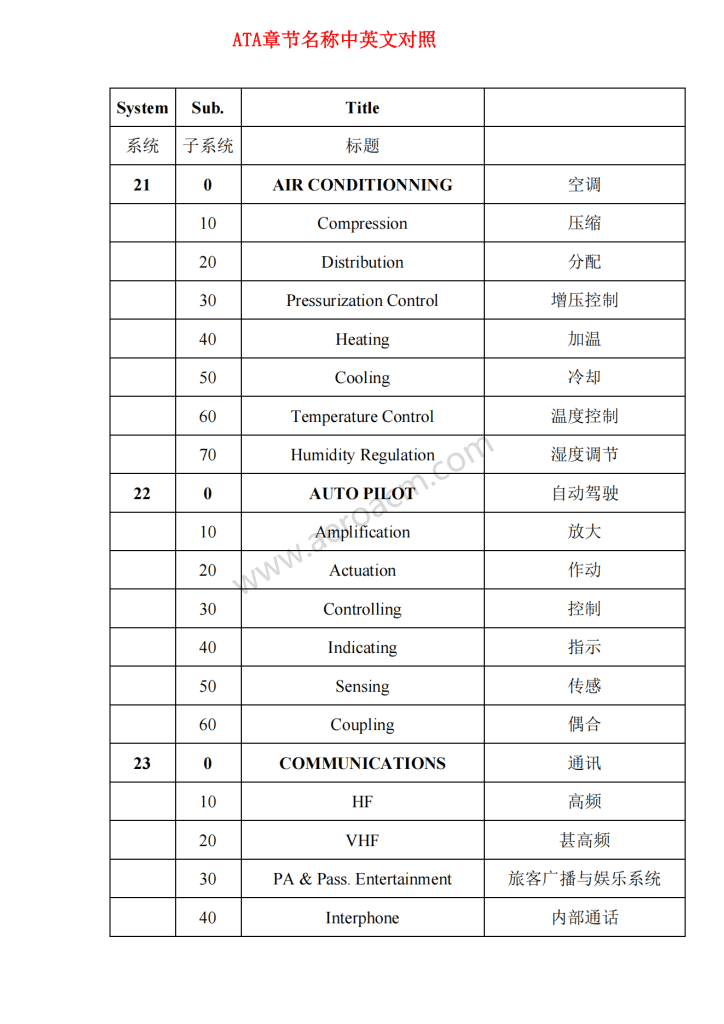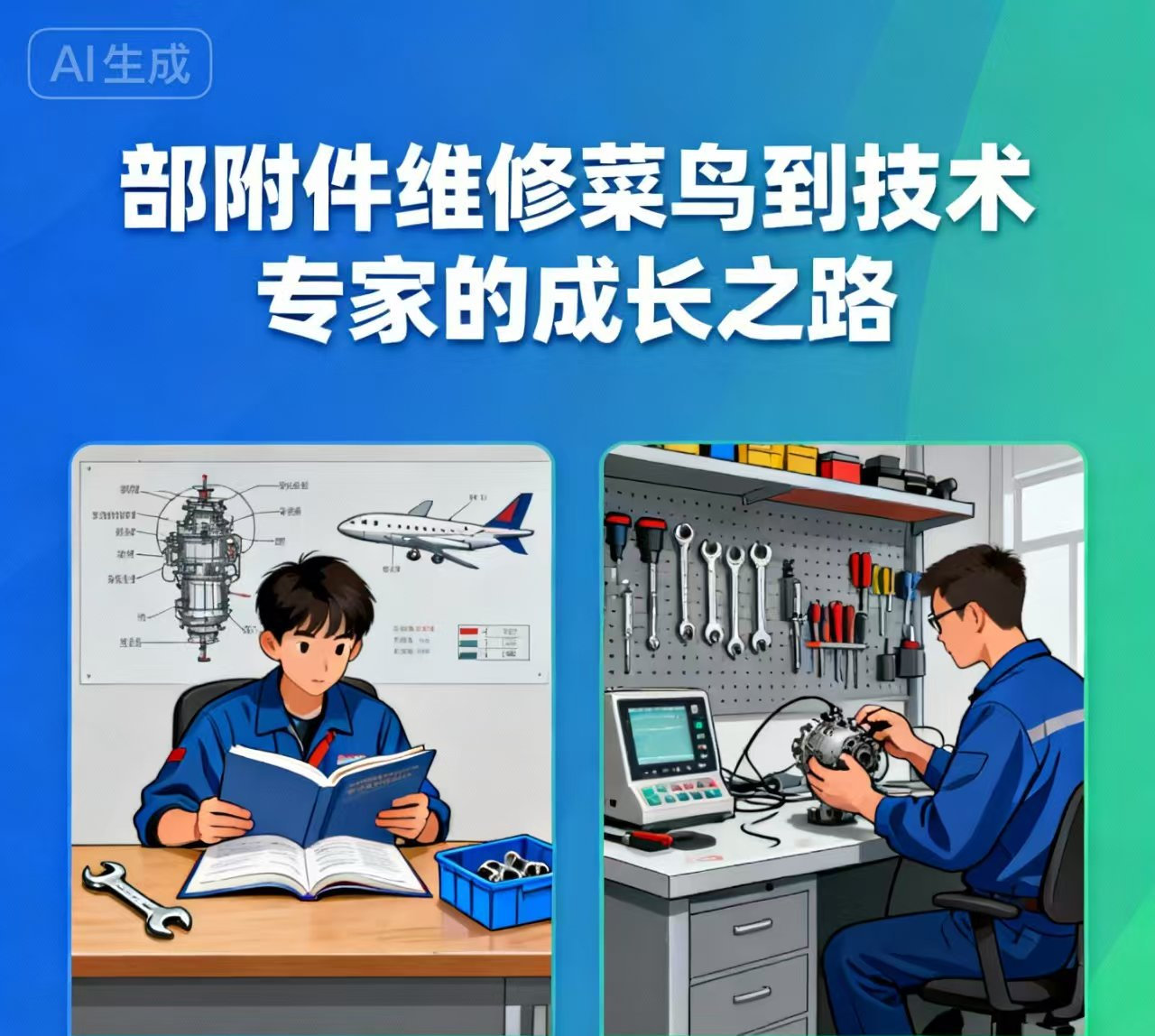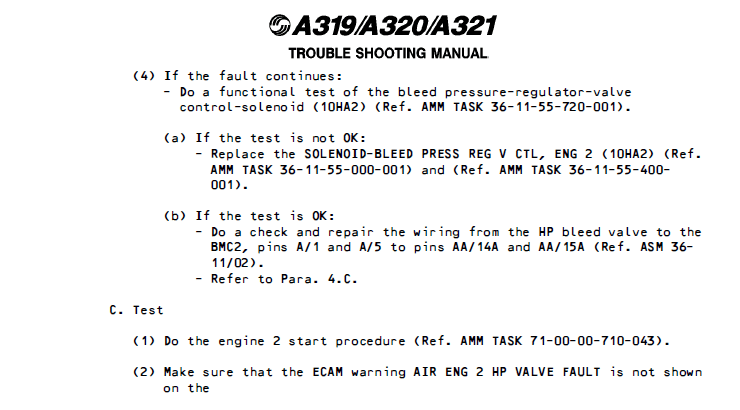浅谈发动机引气压力波动 Discussion on Engine Bleed Pressure Fluctuation
原理分析
Principle analysis


引气原理图 pneumatic system-schematic
之前TSM上有两种发动机引气波动排故程序:
Previously, there were two engine bleed wave troubleshooting programs on TSM:
1.引气压力在14-44PSI之间波动:TSM 36-11-00-810-899A
Bleed air pressure fluctuates between 14-44 psi: TSM36-11-00-810-899A

引气压力在这个区间变化,主要的怀疑故障件是CTS,或3号感压管。
Bleed air pressure varies in this interval, and the main suspected fault is CTS, or sense line 3.
2.引气压力在8-50PSI之间波动: TSM 36-11-00-810-901A
Bleed air pressure fluctuates between 8-50PSI:TSM 36-11-00-810-901A

引气压力在这个区间变化,主要的怀疑故障件是CTS,或2号感压管(PRV上游和CTS之间的感压管)。2号感压管也用于给压力传感器(7HA)供压,用于监控PRV进口的引气压力值。
Bleed air pressure varies in this interval, and the main suspected fault is the CTS, or No. 2 pressure tube (the pressure tube between the upstream PRV and the CTS).The sense line 2 is also used to feed the pressure sensor (7HA) to monitor the bleed air pressure value at the PRV inlet.
而现在手册将小幅度波动和大幅度波动的情况整合在一起了,统一在TSM 36-11-00-899A,删除了TSM 36-11-00-810-901A。
The manual now integrates small fluctuations and large fluctuations under TSM 36-11-00-899A, and removes TSM 36-11-00-810-901A.

例如:如果引气压力波动在40 psi (2.76 bar)和48 psi (3.31 bar)之间或36 psi (2.48 bar)和44 psi (3.03 bar)之间: 停止排故。
For example: If the bleed pressure fluctuation was between 40 psi (2.76 bar) and 48 psi (3.31 bar) or 36 psi (2.48 bar) and 44 psi (3.03 bar): Stop the troubleshooting procedure.
因为PRV在40 psi (2.76 bar)和48 psi (3.31 bar)之间有正常的波动。HPV (4000HA)和IP止回阀之间的自动切换可以导致36 psi (2.48 bar)到44 psi (3.03 bar)的波动。
Because the PRV has normal fluctuations between 40 psi (2.76 bar) and 48 psi (3.31 bar).Automatic switching between the HPV (4000HA) and the IP check valve can cause the fluctuations from 36 psi (2.48 bar) to 44 psi (3.03 bar).
如果引气压力波动不在40 psi (2.76 bar)和48 psi (3.31 bar)之间或36 psi (2.48 bar)和44 psi (3.03 bar)之间:检查接头和/或感压管1、感压管2、感压管3、感压管4和感压管6的夹具,并在设备层面进行检查。
If the bleed pressure fluctuation was not between 40 psi (2.76 bar) and 48 psi (3.31 bar) or 36 psi (2.48 bar) and 44 psi (3.03 bar): Do a check of the unions and/or the clamps of sense line 1, sense line 2, sense line 3, sense line 4 and sense line 6 with the check at the equipment level.
CTS通过2号感压管感受PRV上游压力是为了探测反流。CTS通过释放3号感压管压力,减小和关闭PRV。当2号和3号感压管的漏气时,PRV压力的调节范围不一样。其中2号感压管的漏气,即探测到反流会造成引气更大范围的波动。
The CTS senses the upstream pressure of the PRV through the sense line 2 in order to detect reverse. The CTS reduces and shuts down the PRV by releasing pressure from the sense line 3. When sense line 2 and 3 leak, the adjustment range of PRV pressure is not the same. Among them, the leakage of the sense line 2, that is, the detection of reverse flow, will cause a wider range of fluctuations in the bleed air.
CTS(10HA)
CTS的工作原理
How CTS works

CTS位于发动机吊架内,预冷器出口,感受预冷器出口温度。CTS有两种工作模式,电动模式(关断)和气动模式(调节)。引气系统出现故障时,CTS接收BMC指令,使三号感压管放气,控制PRV的调节和关断。
The CTS is located in the engine hanger, the outlet of the precooler, feel the temperature of the outlet of the precooler. The CTS has two operating modes, electric mode (off) and pneumatic mode (adjust). When the bleed air system fails, the CTS receives BMC instructions to deflate the sense line 3 and control PRV adjustment and shutdown.
电动模式
electric mode
以下情况下,BMC会发电信号给CTS,做动电磁阀,使排气口完全打开,三号感压管被完全放气,使PRV完全关闭。
In the following cases, the BMC will generate a signal to the CTS, operate the solenoid valve, so that the exhaust port is fully opened, the sense line 3 is fully deflated, and the PRV is completely closed.
1.发动机引气电门OFF;
The engine BLEED P/B is selected”OFF”;
2.发动机灭火电门OFF;
The engine FIRE P/B is RELEASED OUT;
3.预冷器下游过热-热交换器出口温度传感器检测温度高于257°C(527°F);
Over-temperature downstream of the precooler – the heat exchanger outlet temperature sensor senses a temperature above 257°C (527°F);
4.当调压传感器检测到压力大于57psi时,PRV下游的超压;
Overpressure downstream of the PRV when the pressure-regulated transducer senses a pressure greater than 57 psi;
5.吊架/机翼/机身管道及周围区域的泄漏检测;
Leak detection in pylon/wing/fuselage ducts and surrounding areas;
6.APU引气活门未关闭;
APU bleed valve not closed;
7.相应的启动活门未关闭。
corresponding starter valve not closed.
气动模式
pneumatic mode
即反流保护。PRV的下游压力大于上游压力(即2号感压管压力)0.145PSI时,CTS工作在气动模式下,触发反流保护。
That is, reverse protection. When the downstream pressure of the PRV is greater than the upstream pressure (that is, the sense line 2 pressure) by 0.145PSI, the CTS operates in pneumatic mode and triggers the reflux protection.

图1

蓝腔压力大时,膜盒右偏,没有反流输出。当蓝腔压力小时,膜盒左偏,电磁阀上移打开排气口,3号感压管逐渐放气,PRV逐渐减少开度。
When the pressure of the blue cavity is high, the diaphragm is tilted to the right and there is no reflux output. When the pressure of the blue chamber is small, the diaphragm box is left, the solenoid valve is moved up to open the exhaust port, the sense line 3 is gradually deflated, and the PRV is gradually reduced in opening.
1. 2号感压管漏气,或者膜盒破损,膜盒会向左运动,触发CTS的反流保护。2号感压管是否漏气,可以通过解码,检查7HA传感器值来判断,如果漏气,这个值会异常,波动或偏小。
If the sense line 2 leaks, or the capsule is damaged, the capsule will move to the left, triggering the CTS’s reverse protection. Whether the sense line 2 leaks bleed air can be determined by decoding and checking the 7HA sensor value. If the gas leaks, the value will be abnormal, fluctuate or be small.
2. CTS的蓝色标识腔漏气,会导致气压降低,这种失效往往体现为:慢车时,引气压力有明显波动。假设发动机功率增加,PRV上游压力变大,当上游压力大于下游压力,反流现象消失,引气压力自动恢复正常。因此,CTS探测到虚假的反流,慢车时故障明显,高功率时,故障消失。
The blue marking chamber of the CTS leaks air, which will lead to a decrease in air pressure, and this failure is often reflected in: when the train is in slow motion, the bleed air pressure has a significant fluctuation. Assuming that the engine power increases and the PRV upstream pressure increases, when the upstream pressure is greater than the downstream pressure, the reflux phenomenon disappears, and the bleed air pressure automatically returns to normal. Therefore, the CTS detects false backflow, the fault is obvious at slow running, and the fault disappears at high power.
CTS的故障方式和检查方法
Fault mode and check method of CTS
CTS故障导致三号感压管漏气是很常见的一种失效。PRV会出现错误关断和错误调节。正常情况下,单向活门处于关闭状态,确保三号感压管内的压力稳定。
CTS failure resulting in sense line 3 leakage is a very common failure. The PRV will misturn off and misadjust. Under normal circumstances, the check valve is closed to ensure that the pressure in the sense line 3 is stable.
1. 单向活门没有关严:此活门受电磁阀和反流保护功能的控制。BMC探测到超温或超压,给电磁阀通电,做动单向活门。或反流时,气动模式下,做动此单向活门。
措施:出现ECAM警告AIR ENG2 BLEED ABNORM PR ,可尝试复位发动机引气电门。该操作实际是给CTS通断电,即复位单向活门。如果引气能恢复正常,可初步判断是单向活门关不严导致。
check valve is not tight: This valve is controlled by the solenoid valve and the reverse protection function. The BMC detects overtemperature or overpressure, energizes the solenoid valve, and makes a check valve. Or reverse flow when in pneumatic mode, do this check valve.
Action: ECAM warning AIR ENG2 BLEED ABNORM PR, try to reset engine bleed switch. This operation is actually to power off the CTS, that is, to reset the check valve. If the bleed air can return to normal, it can be preliminarily judged that the check valve is not tightly closed.
2. 二号感压管或者膜盒漏气:均会使图1中的蓝色标识压力下降,出现虚假的反流现象,使PRV开度变小,引气压力变得不正常。严重的会触发ECAM警告AIR ENG2 BLEED ABNORM PR ,伴有故障信息PRESS REG-V 4001HA2 OR SOL 10HA2OR SENSE LINE。
措施:在CTS的两个管接头处,通入气体,用泡沫水检查膜盒和通风口是否漏气。如有漏气,说明此CTS故障。
Leakage of sense line 2 or capsule: both will cause the blue marked pressure in Figure 1 to drop, resulting in false reflux phenomenon, making the PRV opening smaller and the bleed air pressure abnormal. In severe cases, the ECAM will warn the AIR ENG2 BLEED ABNORM PR with the fault message PRESS REG-V 4001HA2 OR SOL 10HA2OR SENSE LINE.
Measures: Pass nitrogen into the two tube joints of the CTS, and check the diaphragm and vent for air leakage with foam water. If air leaks, the CTS is faulty.

感压管漏气对PRV的影响
Effect of leakage of sense line on PRV
2号感压管漏气
sense line 2 is leaking
以上已经分析,CTS会认为探测到反流,使3号感压管逐渐放气,使PRV开度减小。2号感压管感受到的PRV进口的压力,如果存在漏气,在慢车时,故障现象更明显。高功率下,气压压力能弥补渗漏的气体,2号感压管的压力会恢复,反流现象会消失。
According to the above analysis, CTS will think that the detection of reflux will gradually deflate the sense line 3 and reduce the opening of PRV. If the pressure of the PRV inlet felt by the sense line 2 is leaking, the fault phenomenon is more obvious when the train is in slow motion. At high power, the air pressure can make up for the leaking gas, the pressure of the sense line 2 will recover, and the reverse phenomenon will disappear.
3号感压管漏气
sense line 3 is leaking
3号感压管和PRV-D腔相连。3号感压管漏气,会导致PRV-D压力下降,单向活门会打开使PRV-B腔放气,B腔是PRV的打开腔,压力下降会导致PRV开度关小,或全关。
sense line 3 is connected to the PRV-D chamber. The leakage of the sense line 3 will cause the PRV-D pressure to drop, and the unidirectional valve will open to deflate the PRV-B chamber, which is the opening chamber of the PRV, and the pressure drop will cause the opening of the PRV to be reduced or completely closed.
PRV的工作原理
How PRV works

PRV活门与两根感压管连接,3号和1号感压管,分别控制自身和HPV的关闭。
The PRV valve is connected to two sense line, No. 3 and No. 1, which control the closing of themselves and HPV, respectively.


PRV的工作原理
1. 3号感压管释压,会使PRV-B腔压力下降,PRV会关闭。
The pressure release of the sense line 3 will cause the pressure of the PRV-B chamber to drop and the PRV will be closed.
2. 3号感压管释压,会使PRV-C腔压力下降,1号感压管压力也下降,所以HPV也会关闭。可见,PRV关闭,HPV肯定也关闭。但是HPV关闭,并不会影响PRV的工作。
The pressure release of the sense line 3 will decrease the pressure of the PRV-C cavity, and the pressure of the sense line 1 will also decrease, so HPV will also shut down. So PRV is off, HPV must be off. However, HPV shutdown does not affect the work of PRV.
3. PRV-C腔有一单向活门,如果C腔气压下降,1号感压管压力也会下降。但是假如1号感压管漏气,压力下降,单向活门就会关闭,这样1号感压管就不会影响到PRV的工作。
The PRV-C chamber has a check valve, and if the pressure in the C chamber drops, the pressure in the sense line 1 will also drop. However, if the No. 1 pressure tube leaks and the pressure drops, the check valve will be closed, so that the snese line 1 will not affect the work of the PRV.
HPV 的工作原理
How HPV works

HPV活门只与一根感压管相连,即1号感压管。1号感压管与HPV打开腔相连。
The HPV valve is connected to only one sense line, the sense line 1. Sense line 1 is connected to the HPV opening chamber.


HPV的工作原理
1. 正常情况下,发动机低功率运转,HPV上游的压力就可进入HPV打开腔和1号感压管,且HPV关闭腔通大气,所以HPV打开。
Under normal circumstances, the engine runs at low power, and the upstream pressure of HPV can enter the HPV opening cavity and the No. 1 pressure tube, and the HPV closing cavity passes through the atmosphere, so the HPV opens.
2. 正常情况下,发动机高功率运转。IPV出口压力增大,即HPV下游压力增大,下游压力会进到HPV关闭腔,使HPV关闭。
Under normal conditions, the engine runs at high power. The IPV outlet pressure increases, that is, the downstream pressure of HPV increases, and the downstream pressure will enter the HPV closing chamber, making HPV closed.
3.1号感压管漏气:
Leakage of sense line 1:
慢车时,HPV打开腔压力下降,HPV开度减小或者关闭。
In idle run, the pressure of the HPV opening cavity decreases, and the HPV opening decreases or closes.
高功率时,1号感压管无论是否漏气,HPV都会关闭。
At high power, HPV will turn off regardless of whether the No. 1 pressure tube is leaking or not.
1号感压管与PRV-C腔相连,但PRV-C腔内的单向活门,会保证PRV不受1号感压管漏气的影响。
The sense line 1 is connected to the PRV-C chamber, but the one-way valve in the PRV-C chamber ensures that the PRV is not affected by the leakage of the sense line 1.
感压管分布
sense line rounting


1号 感压管:PRV–HPV:PRV关闭时,此管路放气,使HPV关闭;HP电磁阀通电时,此管路放气,HPV关闭。管路漏气会导致HPV打开功能不正常,或者引气压力波动;甚至导致HPV会打不开。
Sense line 1: PRV–HPV: When PRV is off, the pipeline is deflated to turn off HPV; When the HP solenoid valve is energized, this line is deflated and HPV is closed. Pipeline leakage can lead to abnormal HPV opening function, or bleed air pressure fluctuation; It can even cause HPV to stop opening.
2号感压管:PRV上游–TLT–Pt传感器:使TLT感受PRV上游压力,若PRV上游压力与PRV下游压力差减少到低于0.145psi,TLT的防返流功能使PRV关闭,若此管路漏气,会导致PRV反复开关从而使引气压力波动,双发引气打开不一致,或Pt(转换压力)读数错误,如2号管断裂等渗漏情况严重,容易导致PRV反复开关,下游引气压力低,从而无法打开FAV,导致引气超温跳开而关闭PRV;
Sense line 2:PRV Upstream –TLT–Pt sensor: Make the TLT feel the upstream pressure of the PRV. If the difference between the upstream pressure of the PRV and the downstream pressure of the PRV is reduced to less than 0.145psi, the anti-backflow function of the TLT will shut the PRV off. If the pipeline leaks, the PRV will be switched on and off repeatedly, which will cause the bleed pressure to fluctuate, the dual bleed air opening is inconsistent, or the Pt (conversion pressure) reading is wrong. If the leakage of No. 2 pipe is broken, it is easy to lead to PRV switching repeatedly, and the downstream bleed air pressure is low, so that FAV cannot be opened, resulting in bleed air overtemperature jump and PRV closing;
3号感压管:PRV–TLT:当TLT感受到预冷器下游温度过高,给此管路部分放气,关小PRV;当TLT电磁阀通电,或PRV下游压力接近上游压力时,此管路完全打开放气,关闭PRV。如果3号管漏气会导致压力波动,PRV活门打开功能不正常,甚至打不开;
Sense line 3:PRV–TLT: When TLT feels that the downstream temperature of the precooler is too high, the pipeline part is deflated and the PRV is turned down. When the TLT solenoid valve is energized, or the downstream pressure of the PRV is close to the upstream pressure, the line is fully opened and the PRV is closed. If No. 3 tube leakage will cause pressure fluctuations, PRV valve opening function is not normal, or even can not be opened;
4号感压管:PRV下游–Pr传感器:连接PRV下游用于监控引气压力,用于ECAM指示,若漏气将影响引气压力读取以及超压的探测;
Sense line 4:PRV downstream –Pr sensor: connected to PRV downstream for monitoring bleed air pressure, for ECAM indication, if leakage will affect bleed air pressure reading and overpressure detection;
5号感压管:FAV–TCT:给FAV提供打开压力,用于控制FAV开度,压力越高,FAV开度越大,若漏气可能使FAV无法调节到达打开位,使引气温度持续变高;
Sense line 5:FAV–TCT: provide the opening pressure to the FAV to control the opening of the FAV, the higher the pressure, the greater the opening of the FAV, if the leakage may make the FAV can not adjust to the open position, so that the bleed air temperature continues to increase;
6号感压管(如果安装):PRV—Gimbal:连同PRV本身自带的下游压力感应口一起感受PRV出口压力,用于调节PRV出口压力(下游压力大,关小PRV,下游压力减小,PRV开大),使出口压力稳定在44psi左右;若管路漏气将导致引气压力过高。
Sense line 6(if installed): PRV-gimbal: Feel the PRV outlet pressure together with the downstream pressure sensing port of the PRV itself, and adjust the PRV outlet pressure (the downstream pressure is large, turn down the PRV, reduce the downstream pressure, and increase the PRV), so that the outlet pressure is stable at about 44psi; If the pipe leaks, the bleed air pressure will be too high.
异常现象分析
Anomaly analysis
1.地面,双发慢车,APU关闭,空调ON位(发动机功率低)
ON ground, two engines idle run, APU off, air conditioning ON (low engine power)
异常现象1
Anomaly 1
慢车时,有几个时刻出现过HPV2和PRV2同步关闭。HPV关闭,IPV出口的引气也可以打开PRV,所以是PRV2的关闭引起了HPV2关闭。重点研究问题是,为什么PRV2会关闭。可能是3号感压管或者CTS漏气。
There are several moments when the HPV2 and PRV2 are turned off simultaneously. When HPV is off, the bleed air at the IPV outlet can also turn on the PRV, so it is the shutdown of PRV2 that causes the HPV2 to shut down. The key research question is why PRV2 shuts down. Could be a pressure three or a CTS leak.
异常现象2
Anomaly 2
PRV2出口压力在5-18.5PSI之间不断波动,说明PRV2出现了异常调节,初步判断是CTS在调节PRV开度。
The outlet pressure of PRV2 fluctuates continuously between 5-18.5PSI, indicating that PRV2 has abnormal regulation, and the preliminary judgment is that CTS is adjusting the PRV opening.
PRV出现了气动调节,根据引气压力的波动范围,可判断属于8-50PSI,大幅度波动的情况。根据上述分析三号感压管和CTS的可能性较大。
PRV has pneumatic regulation, according to the fluctuation range of bleed air pressure, it can be judged to belong to 8-50PSI, large fluctuations. According to the above analysis, the possibility of sense line 3 and CTS is greater.
2.空中, 空调组件、大翼防冰ON(发动机功率高)
In flight, PACK and wing anti-icing ON (high engine power)
异常现象1
Anomaly 1
Anomaly 1
右大翼防冰活门交替开关。大翼防冰活门电控气动,20-25PSI可使其打开。PRV2出口的引气压力在17.5-39.5PSI之间变化,说明到了大翼防冰管里的气体压力可能下降到20PSI以下。活门交替开关说明活门进口压力波动。如果引气压力低于12PSI时,状态页会出现INOP信息WING ANTI ICE 。
Right wing ice valve alternate switch. Large wing anti-icing valve electronically pneumatic, 20-25 psi can make it open. The bleed air pressure at the PRV2 outlet varies between 17.5 and 39.5PSI, indicating that the gas pressure in the large wing anti-icing tube may drop below 20PSI. Valve alternating switch indicates valve inlet pressure fluctuation. If the bleed air pressure is below 12PSI, the INOP message WING ANTI ICE appears on the status page.

异常现象2
Anomaly 2
PACK1流量稳定,而PACK2流量有波动。双组件的流量均由ACSC1计算,正常情况下应一致或者有小差别。说明右发引气波动,也影响到了PACK2的流量。
The flow of PACK1 is stable, but the flow of PACK2 fluctuates. The flow rate of both components is calculated by ACSC1 and should be consistent or slightly different under normal circumstances. This indicates that the right bleed air fluctuation also affects the flow rate of PACK2.
异常现象3
Anomaly 3
PRV时关时开。如图4中所述CTS导致PRV关闭的原因推断,CTS反流保护的可能性较大。飞行过程中,较低功率时,反流保护释放部分3号感压管压力,PRV2出口压力下降,由于影响了PACK2的工作,ACSC2发指令给EEC2,要求增加功率,增加了发动机功率,增加了PRV2进口压力,反流现象缓解,PRV2出口压力上升。
The PRV is off and on. The reason why CTS causes PRV shutdown as shown in Figure 4 suggests that CTS reflux protection is more likely. During the flight, when the power is low, the reverse flow protection releases the pressure of the No. 3 pressure sensor tube, and the PRV2 outlet pressure drops. Due to the impact on the work of PACK2, ACSC2 sends instructions to EEC2 to increase the power, increase the engine power, increase the PRV2 inlet pressure, the reverse flow phenomenon is relieved, and the PRV2 outlet pressure rises.
对于压力低,主要检查CTS,其次是PRV;对于压力摆动不定,主要检查PRV,其次是CTS。
For low pressure, the main check CTS, followed by PRV; For pressure fluctuation, PRV is mainly checked, followed by CTS.
排故流程图(以2发为例)
Troubleshooting flowchart (Take engine 2 as an example)




AIDS中相关的LABEL CALL UP
The associated LABEL CALL UP in AIDS

PRV1和PRV2的出口压力 LABLE CALL UP分别为06F/1/142/01或06F/2/142/10和06F/1/143/01或06F/2/143/10,ALPHA CALL UP 为PD。BMC的设备代码为06F,代码为二进制代码(BNR),LSB为第19位,工程系数为0.5,单位Psig。
The outlet pressure LABLE CALL UP of the PRV 1 and PRV2 is 06F/1/143/01 or 06F/2/143/10 and 06F/1/142/01 or 06F/2/142/10, respectively, and the ALPHA CALL UP is PD. BMC’s device code is 06F, code is binary code (BNR), LSB is 19th, resolution is 0.5, unit is Psig.
PT1和PT2的压力LABLE CALL UP 分别为06F/1/152/01 or 06F/2/152/10 and 06F/1/153/01 or 06F/2/153/10,代码为二进制代码,LSB为第19位,工程系数为0.5,单位为Psig。
The pressure LABLE CALL UP of PT1 and PT2 is 06F/1/152/01 or 06F/2/152/10 and 06F/1/153/01 or 06F/2/153/10 respectively, the code is binary code, the LSB is the 19th digit, and the resolution is 0.5. The unit is Psig.
参考资料:
Reference materials:
[1] Airbus AMM,ASM,TSM AIPL
[2]飞机引气压力波动
来源:
📌 原文链接:https://mp.weixin.qq.com/…










暂无评论内容